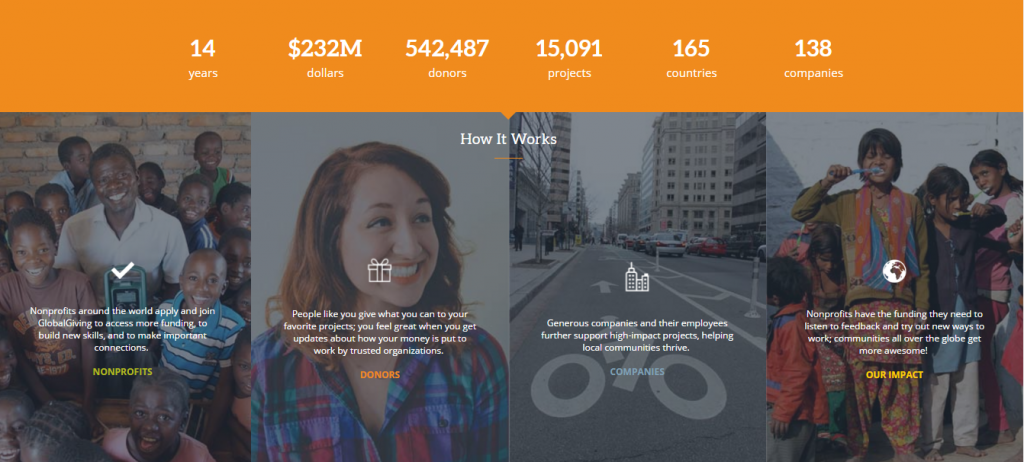Case Study: GlobalGiving Email Marketing Personalisation Programme

In this post we will talk about email marketing for GlobalGivingthe world's first and largest crowdfunding community. A community that has subscribers all over the world and needs to send highly engaging and relevant content to its users.

Out of the need to reach all of its subscribers in the best possible way, GlobalGiving's marketing team created an email marketing personalisation programme with the aim of targeting donors in the community in a more individualised way.
GlobalGiving sends more than 3.5 million emails in one year alone, which means that email is a key channel in the marketing strategy of this community. But, as we have said many times before, quantity is nothing without quality. So, GlobalGiving's marketing team implemented a personalisation programme to ensure that their emails contain the right content for each of the users registered in their database..
It is becoming increasingly difficult to capture the attention of users, so it is not enough to simply create good content if you do not reach different users correctly. When we talk about personalisation, we are not only talking about personalising the subject line or the first few lines of an email, but also about personalising the entire content of the email, offering users what they really want to receive according to their tastes and interests.
What is GlobalGiving's email marketing personalisation programme?
The programme is divided into 3 main blocks that complement and feed into each other:
1. Creation of a list of quality contacts
The GlobalGiving team realised the need to look at who they were sending their emails to and how these emails were arriving in their inboxes. This is how they started working with certified emails and how by studying the different domains they could observe how the emails arrived in their inboxes.
Thanks to the study of the different domains and the observation of the different metrics that measure the effectiveness of the emails, they were able to realise that in some cases the spam rate was higher than normal compared to other emails. This meant that, in some cases, the reputation of their campaigns could be affected. So identifying "problem" users and removing them from the database could maximise the effects of the campaign and keep the contact list clean. There is little point in sending emails to users who will receive our emails in the spam folder.
"An email program's reputation reflects the reputation of your brand". Kevin Conroy, Chief Product Officer of GlobalGiving.
For example, they came across a case where a domain had a spam rate of 5%, as opposed to 0.1% for the vast majority of emails. The problem was in the language of the email, as the user was from a non-English speaking country. By carrying out a transaction in English, it was assumed that the user spoke English. The solution was to remove the domain from the list to control the potential damage to their contact list.
Ultimately, the first step in personalising GlobalGiving email marketing is to keep your contact list pristine in order to ensure that you are targeting the right people.
2. Developing a personalised referral programme
Once the right people are in place, the second step focuses on developing a recommendation programme similar to the one used by Netflix. This consists of analyse users' behaviour with the brand in order to offer different recommendations.based on previous habits and interests.
For example, if a person donates money to help animals, following this programme, a recommendation will be sent to the user related to this issue. The idea of "As I know that you are interested in animals, perhaps you would like to collaborate in this donation" is more effective than many can imagine.

The team looked at the data and assets available from the database and found they had enough information to develop a personalised recommendation programme. That, combined with the use of email best practices, such as the use of games, urgent appeals... made GlobalGiving's emails much more engaging.
3. Constant use of A/B testing
Finally, observing user behaviour alone is not enough. To fully guarantee the success of its campaigns, GlobalGiving incorporated the constant use of the A/B Testing in the day-to-day work of its marketers. The community makes use of testing as a way of discovering the right language to work well with your contact list.
With the tests, GlobalGiving aims to compare the different designs on different devices, to find out which content is of most interest to its donors... In short, to find the ideal email for each of its users. In addition, with the use of testing, it has also been able to verify that, effectively, emails containing donation recommendations get much better results than those receiving random donation emails..
What are the results of the personalisation programme?
Through the implementation of this programme, GlobalGiving has been able to observe that on engagement of email marketing campaigns is 10 times higher It also helps to maintain the quality and reputation of a service that is indispensable in this type of organisation.
"Before ... I felt like we were in a large room, we'll call the Internet, and we had a bunch of paper airplanes, we'll call emails, and we're throwing them across the internet, across the room, trying to get them to our donors and we had no idea if it was working or not." Kevin Conroy, Chief Product Officer of GlobalGiving.
This type of campaign gives you a control that, as Conroy rightly says, has not existed until now. A control that allows you to improve the user experience and gain their trust. The reputation of this type of campaign is fundamental for defining the brand reputation. Especially if we are talking about non-profit organisations, where the main objective is to gain the trust of users.
GlobalGiving asked itself... If you can't gain their trust in their inboxes, how will you gain their trust to donate?
Access here for more success stories.